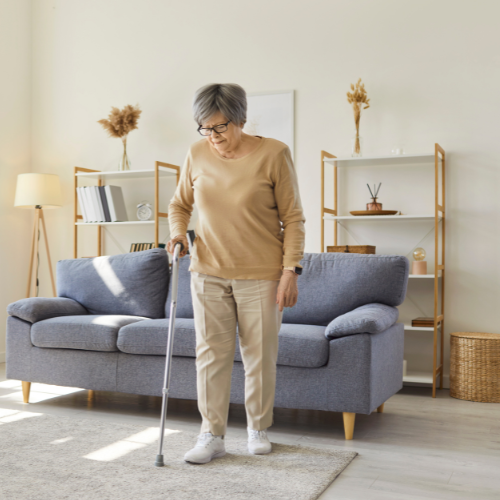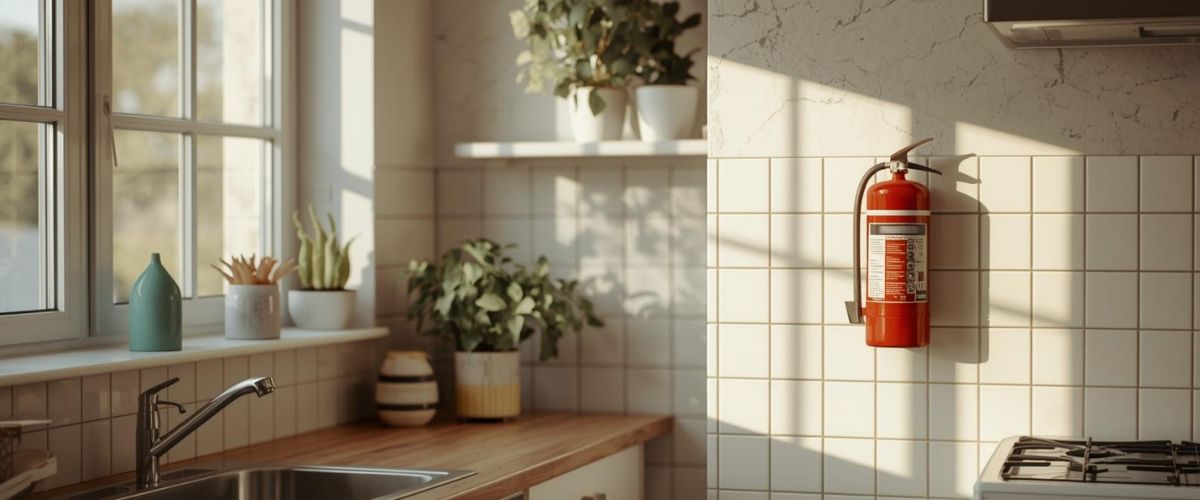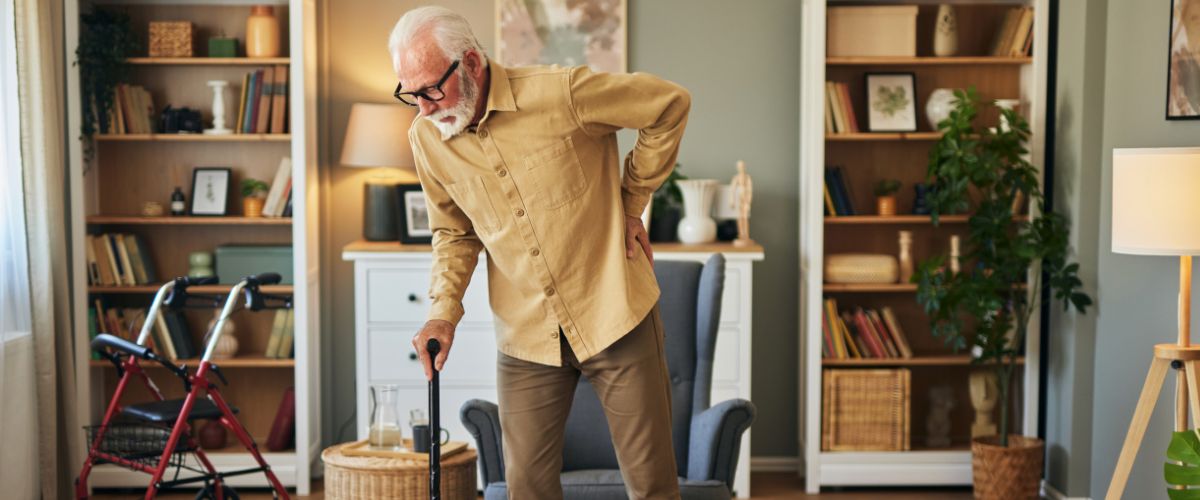Picture this: You’re 75, sitting in the living room where you celebrated your kids’ birthdays, hosted countless holiday dinners, and built a lifetime of memories.
The thought of leaving is unbearable. But lately, the stairs feel steeper, the bathtub seems deeper, and you’re starting to wonder if staying home is actually realistic.
This is the story of millions of seniors.
Here’s the thing, though: aging in place is absolutely possible with the right preparation.

Nearly 90% of people want to stay in their homes as they age, and honestly, who can blame them? Your home represents independence, comfort, and decades of memories you’re not ready to pack up and leave behind.
This aging-in-place checklist walks you through everything you need to make your home safe, accessible, and comfortable for the long haul. We’re not talking about turning your house into a hospital ward. We’re talking about smart, practical changes that let you keep living life on your terms.
The best time to prepare is before you need the help. So, let’s get started.
Before you dive in, here’s what you need to know: preparing your home for your senior years isn’t about doing everything at once. Nobody’s expecting you to renovate your entire house next weekend.
Start with immediate safety concerns, such as things that reduce fall risk right now. Then tackle the modifications that’ll make life easier in the coming years. Some items on this list are for today, others are for planning ahead.
Think of this checklist in two parts: the physical changes to your home, and the support systems you’ll need around you. Both matter equally.
Revisit this list whenever your needs change. Download it, print it, share it with family – whatever helps you stay on track. The goal is progress, not perfection.

Falls are the leading cause of injury among seniors, but most are completely preventable with a few smart modifications.
So, let’s go over the changes that reduce fall risk and prevent accidents today, regardless of your current mobility level.
Your kitchen sees a lot of action, which means it also sees a lot of potential hazards. Some necessary modifications for a quick boost on safety include:
The cherry on top? Keep a fire extinguisher within easy reach near the stove, somewhere you can grab quickly.

The bathroom is where most falls happen. Your bathroom is slippery, cramped, and full of hard surfaces. To make it safer, you should:

Stairs become one of our biggest enemies as we age. If you’re not quite ready to move your bedroom downstairs, these modifications make walking up and down the stairs a lot safer_
If stairs are becoming genuinely difficult, consider moving your bedroom to the main floor. Using a spare room or even converting a dining room might seem drastic, but it’s better than risking a fall every day.

Aging eyes need about three times more light than younger eyes. Poor lighting is a massive fall risk that’s incredibly easy to fix:

A few more basics that’ll make your entire home safer:

Now let’s talk about modifications that help with current or future mobility challenges.
Maybe you’re using a cane now, or maybe you’re planning ahead for when a walker or wheelchair might be necessary.

Doorways and entryways are some of the most important parts of your home for mobility:

Your bedroom should be a safe haven, not a hazard zone:

Where you spend most of your time deserves attention, too:

What’s under your feet matters more than you think:
Modern technology can maintain your independence longer and give everyone peace of mind.

Let’s be honest – if you live alone or spend significant chunks of time by yourself, a medical alert system isn’t optional. It’s essential. Period.
These systems connect you to 24/7 monitoring with a button press. Fall and can’t get up? Chest pains? Intruder in your house? Need just someone to talk to? Help arrives within minutes.
Systems like LifeStation offer both home-based and mobile options, ensuring help is available whether you’re in your garden or at the grocery store. Their devices start at $35.95 per month, include 24/7 professional monitoring, and come with a 30-day money-back guarantee so you can try before fully committing.
LifeStation was established by renowned veterans in the medical alert industry to provide safety and independence to the elderly and support to their caregivers. With three devices designed for both in-home and outside use, including a modern smartwatch, LifeStation protects seniors of all activity levels.
Subscriptions start at $35.95 per month, and you can learn more about its pricing structure by calling +1 (855)-622-7321. If you’d like to try it out first, LifeStation offers a 30-day money-back guarantee, which gives you enough time to get a feel for how its medical alert systems can help you.
The peace of mind alone is worth it. You stay independent, family members worry less, and if something happens, help is seconds away.
Beyond medical alerts, smart home devices make daily life easier.

Staying connected is key to safety:
Eventually, we all reach a point where driving becomes unsafe. Planning for that transition before it happens makes it way less traumatic.

When was the last time you had a driving evaluation?
Many states offer senior driving assessments. An objective opinion helps when everyone’s scared to have the conversation.
Are there signs that driving may become difficult?
Near-misses, getting lost in familiar areas, trouble seeing at night, slower reaction times – these are red flags you can’t ignore.
What’s the backup plan when driving stops?
Don’t wait until someone takes your keys to figure this out. There are plenty of solutions; you just need to have a plan.
The good news? More options exist than ever before:

Research options now before you need them.
Test alternative transportation while you’re still driving to know what works for you, and practice using alternatives like ride-sharing apps with family help. Once you’re comfortable, you’ll feel less dependent.
Remember to budget for increased transportation costs. When you stop driving, you’ll save on car insurance and maintenance but spend more on rides.
Ensure medical providers are accessible via alternative transportation. If your doctor’s office is impossible to reach without driving, find a closer provider now.
Aging in place successfully requires ongoing health and wellness planning.
Your physical health, mental well-being, and social connections all play a role in whether you can stay home safely.

Think about your current medical setup.
Hard-to-reach providers are out of the question. You need providers who are either close to home or accessible through transportation services you can actually use.
At least, telehealth has changed the game. Many checkups, medication reviews, and follow-ups can now happen via video call from your living room. So, talk to your current providers about what they offer remotely.
Prescription delivery is worth setting up before you need it as well. Most major pharmacies deliver directly to your door with automatic refills. Get this sorted while you’re still driving easily.
And here’s the thing no one likes to think about but needs to be planned beforehand – unexpected medical issues. Know your backup transportation options now, not when you’re dealing with a crisis.
Home health services fill the gap between full independence and needing constant care. Physical therapy, wound care, and chronic condition management often happen right at home.

Research home health agencies in your area before you actually need them. Quality varies wildly, and you don’t want to be scrambling when you’re recovering from surgery.
Your doctor is the best starting point for referrals. You can also contact your local Area Agency on Aging (find yours at eldercare.acl.gov), which can connect you with vetted providers in your area.
Medicare covers some home health services, but not everything. Understanding what’s covered under your plan is vital to know what you’ll be paying out of pocket before you need it.
Isolation is a genuine health risk for aging adults. Staying connected to other people actually matters for your physical and mental health.
Your local senior center offers way more than bingo. Exercise classes, educational programs, hot meals, day trips, and most importantly, a built-in community.
Keep up regular social activities even when leaving home gets harder – weekly coffee dates, book clubs, religious services, volunteering are all great ways to connect with others and feel less alone.

When getting out physically becomes difficult, technology helps. Video calls with grandkids, staying in touch on social media, and online communities keep you from disappearing into isolation.
Moreover, adult day programs provide daytime socialization and activities, which are particularly helpful if you live alone.
Movement prevents falls, cognitive decline, and depression. It’s not optional if you want to age in place successfully.
Balance and strength exercises are your best defense against falls. Many senior centers offer free or low-cost classes designed for older adults.
Fall prevention classes, in particular, teach specific techniques for improving stability and how to get yourself up if you do fall.
If you’re dealing with pain or declining mobility, physical therapy addresses the root causes and often prevents further decline.
Nutrition also becomes increasingly important as you age. If cooking is getting hard, meal delivery services solve that problem without requiring you to move.
Aging in place successfully requires ongoing health and wellness planning.

Independence isn’t all-or-nothing. Getting help with certain tasks actually lets you stay home longer – which is the whole point.
If memory issues, balance problems, or forgetting to turn off the stove are concerns, it’s time to make changes. That doesn’t mean you need to move – it means you need different solutions.
Meal delivery ranges from subsidized programs like Meals on Wheels to private services like Blue Apron or Factor that deliver fully prepared meals.
Meanwhile, grocery delivery from Instacart, Amazon Fresh, or local supermarkets eliminates shopping trips entirely.
Simplified cooking appliances like countertop ovens, air fryers, and microwave meals make preparing food easier and safer without requiring a full kitchen renovation.

Be realistic about what’s becoming difficult.
Vacuuming, mopping, changing sheets, and cleaning bathrooms all get harder with age. If family isn’t nearby or available, hire help.
Budget around $100-200 per visit for basic housekeeping every two weeks. Yard maintenance (such as mowing, raking, and gardening) often needs professional help, too. Factor these expenses into your monthly budget.
Snow removal is essential if you live in cold climates. Shoveling is genuinely dangerous and causes heart attacks in older adults. So, make sure to hire someone before winter hits.
This is one of the conversations that no one wants to have, but we need to have it anyway.
When bathing and dressing yourself becomes difficult or dangerous, it’s time for help. Better to plan ahead rather than wait for an accident.

In-home care options range from a few hours per week for basic help to round-the-clock assistance for more complex needs.
Cost varies by location, but expect $25-50 per hour for basic care. It adds up fast, though, which is why planning (and budgeting) matters.
None of the steps mentioned so far work without a solid and proper financial plan. Unless you’re part of the 1%, it’s very likely that you’ll have to think hard about where you’re spending your money to enjoy a stressless retirement.
The most important things you have to think carefully about while making your budget include:

There are some ways for you to get financial assistance:
Documents that you 100% need to get in order:

When it comes to insurance, there are also a few things you need to keep in mind:
Of course, not everyone was born to be a lawyer, and insurance policies can be deceitful. We recommend getting someone to help you understand everything so there are no surprises down the line.
You can’t age in place alone. Building a strong support network is essential, and it needs to include more than just family.
Have honest conversations about future needs now, not when you’re in crisis. Don’t assume family will help – ask directly what they can and can’t do.
Adult children have jobs, families, and lives of their own. Be realistic about what they can actually provide versus what you’re hoping they’ll provide.
Create a schedule for check-ins that works for everyone. Daily phone calls, weekly visits, monthly family dinners, whatever keeps you connected and ensures someone’s regularly checking on you. Share this checklist with family so everyone understands what aging in place actually requires.

Geriatric care managers coordinate care, find services, and handle logistics. They’re worth every penny for complex situations where you need someone to manage multiple providers and appointments.
Beyond care managers, you’ll likely need a mix of other professionals. Home health agencies handle medical care at home, handyman services keep your place maintained and safe, and professional organizers can help you declutter and make spaces more functional. These aren’t luxuries – they’re the support system that actually lets you stay independent.
As already mentioned, a few times in this article, your local Area Agency on Aging is your first stop for community resources and services.
Senior centers provide meals, activities, and community, whereas faith communities often have volunteers who help with rides, meals, and visits.
If you aren’t religious, volunteer organizations match volunteers with seniors who need help. Meanwhile, support groups connect you with others facing similar challenges.
Tap into what’s available in your community. It’s not only raising children that requires a village; aging in place does too.
Assess your current situation: Go through every section with a pen and paper. What do you have? What do you need? What needs immediate attention?
Prioritize: Break items into three categories:
Budget and timeline: Create a realistic plan based on your resources. Maybe you tackle one room per month, maybe you spend tax returns on home modifications, or maybe you apply for assistance programs first. Each person will have a different budget and timeline.
Aging in place successfully requires thorough planning, smart modifications, and building a solid support system.
But Rome wasn’t built in a day.
Install grab bars this month. Research meal delivery next month. Have that hard conversation with family the month after. Every single step forward counts.
The peace of mind that comes from preparation is worth more than you think. You’ll worry less. Your family will worry less. And you’ll actually enjoy your independence instead of constantly stressing about worst-case scenarios.
Safety monitoring systems like LifeStation provide 24/7 monitoring and support, giving both you and your loved ones genuine peace of mind. With devices starting at $35.95 monthly, fall detection options, and both home and mobile systems available, professional help is literally just a button press away. Better yet, you can test it out by taking advantage of the 30-day money-back guarantee.
We recommend saving this checklist to help along the way. You can bookmark it, print it out and stick it on your fridge, whatever you prefer. Most importantly, actually use it. Your future self will be grateful you did.
Costs range widely depending on what you need. Basic safety modifications like grab bars, improved lighting, and non-slip strips can be done for under $500. Mid-range changes like walk-in showers or stairlifts cost $3,000-15,000. Major renovations, including first-floor bedroom conversions and full bathroom remodels, can run $20,000-50,000.
The smart approach? Start with inexpensive safety fixes now and budget for larger modifications over time. Many states offer grants and low-interest loans for home modifications, so we recommend contacting your Area Agency on Aging to learn what’s available locally.
Yesterday. Seriously, the best time to plan is while you’re still healthy and mobile. Making changes before you need them means you’re not scrambling during a crisis. Plus, you’ll have more time to save money, research options, and make thoughtful decisions.
If you’re already experiencing mobility issues or safety concerns, start immediately with the most pressing problems. But even if you’re decades away from needing modifications, creating a plan now means you’ll actually be ready when the time comes.
Hands down, fall prevention measures. Grab bars in the bathroom, improved lighting throughout the house, and removing tripping hazards prevent the most common cause of injury among seniors.
After that, a medical alert system is crucial for anyone living alone or spending significant time without others around. The combination of fall prevention and emergency response capability addresses the two biggest safety concerns.
This is the hardest question, and there’s no universal answer. Red flags include:
The key is having honest conversations with doctors, family, and yourself. Pride shouldn’t override safety. Many people find that assisted living or moving closer to family ultimately provides more independence than struggling alone at home.
Yes, several programs can help:
We recommend starting with your local Area Agency on Aging – they know all available programs in your area.
Share your thoughts, ask questions, and connect with other users. Your feedback helps our community make better decisions.
©2012-2025 Best Reviews, a clovio brand –
All rights
reserved